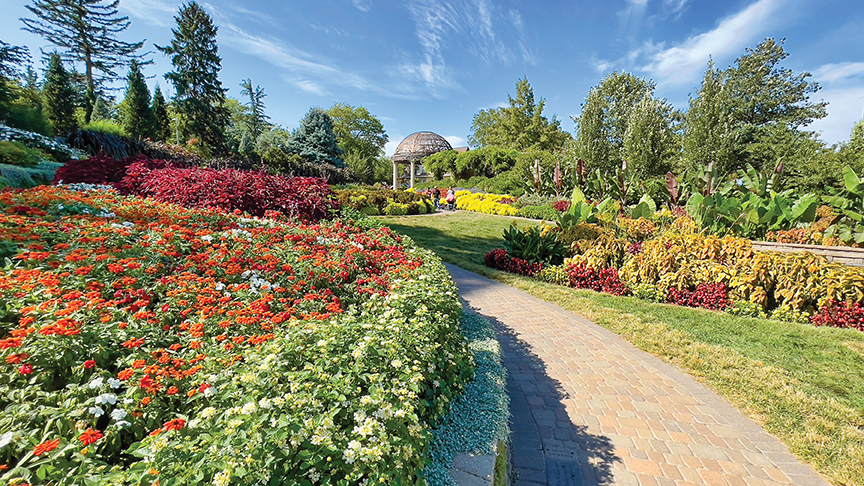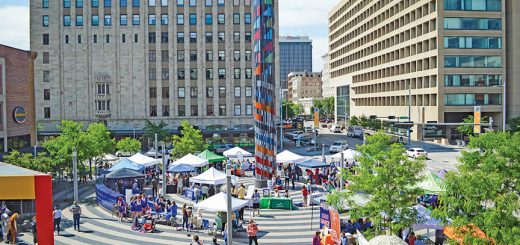Lincolns’ Beautiful Public Gardens

by Tegan Colton, photography by Tom Tidball
Lincoln is famous for many things—football, corn, our stadium, and our terrific university. But what people might not know is that it’s also famous for hosting some of the best gardens in the entire world. That’s no exaggeration.
Lincoln hosts a vast array of natural spots for visitors to enjoy every day of the year—each one special, beautiful, and filled with a deep history of our city and the people who’ve lived here. If you are wondering what to do on any sunny day in Lincoln, visiting any of these gardens will connect you with the splendor of nature and the incredible artistic talent of many of our cities top artists.
Sunken Gardens
What began as a Depression-era project to put Lincolnites to work has bloomed into one of the great wonders of the American Midwest: Lincoln’s Sunken Gardens.
Lincoln has a treasure-trove of hidden flower-fields filled with roses, lilies, perennial plants, grasses, and fountains alike, but the Sunken Gardens is the largest and most famous.
“It’s truly part of the DNA of Lincoln,” said Lynn Johnson, Head of Lincoln’s Parks and Recreation Department. “It attracts visitors not only from Lincoln, but really from all over the world.”
Located at the intersection of 27th and Capitol Parkway, the Sunken Gardens is truly a gorgeous spectacle. The only parts not filled with vibrant colorful flowers, colorful plants, vines, and trees are the brick paths for guests to leisurely stroll on with their friends, families, and lovers. Colors pop brightly as the sun rises and sets, especially the beds of bright red crested cockscomb, with tufts of white wax begonias and purple bigleaf lupines peeking through. Sunny Mexican marigolds, deep red globe amaranths, canna lilies, and rainbow fields of zinnia flowers surround the garden and submerse it in a soothing aroma as the waterfall splashes in the background. Eastern redbud trees and Monterey pines hang over the back paths to provide guests with shade.
The garden also features two rectangular ponds that are scattered with waterlily pads and surrounded by tufts of umbrella palm and Indian shot plants. They are featured in the center of the garden so visitors can come and rest after strolling in the brick paths around them. Behind them lies the small waterfall that cascades next to the staircase that leads to the upper pathways (also accessible by ramp). Guests will also find a circular garden surrounded by white flowers and a striking statue at the center. There are places for guests to sit and enjoy the view, contemplate anything on their minds, or simply be one with nature.
It’s no wonder that National Geographic has named Sunken Gardens as one of the best public gardens in the world.
It’s a spectacle that is free for everyone to appreciate, and it retains its beloved status by being a project that gardeners and interested volunteers from all around Lincoln participate to keep running every year.
“Typically the number varies, but it’s about 35,000 plants that are planted in Sunken Gardens every year,” said Lynn Johnson, Director of Lincoln Parks and Recreation.
“The second Saturday in May, there’s an event called ‘Wake Up the Beds’ where 75 to 100 volunteers will plant a good portion of Sunken Gardens in one day,” he added.
Johnson also added that in the second week of November, there’s an event called “Put the Beds to Bed” where many of the same volunteers will come and hand-spade the garden, apply compost, and prepare it for the winter—again, all in one day.
As if to solidify its place in the hearts of Lincolnites everywhere, guests visiting the garden can see the names of loved ones etched into the bricks on the path—names of those passed away, lovers, anniversaries, weddings, and memories people want to keep cherished forever surrounded by the flower beds in Sunken Gardens. It’s called “Paving the Path,” and anyone can have a brick dedicated for a small fee.
So many people have memories of here, it’s easy to see why people would do it.
“Typically, 50 or more marriages happen in the Gardens every year,” Johnson said. “Obviously, you don’t have to bring your own flowers!”
Local artists have also contributed to Sunken Gardens. Upon entering, guests are greeted by a laser-cut dome called the Rotary Pavilion crafted by local artist Jeff Chadwick that features images of Lincoln’s greatest monuments: the Nebraska state capitol, the grain elevators, the Haymarket water tower, the Union College clock, and an expansive display of the four seasons.
“It’s a pretty special place,” Johnson said. It’s hard to disagree.
Hamann Rose Garden
But the Sunken Gardens isn’t the only flowering treasure in Lincoln. Across the street from the Sunken Gardens lies the Hamann Rose Garden, where a fantastic array of cutting roses of all colors bloom around a beautiful central monument—the Bicentennial Cascade Fountain. It’s a gorgeous brick-paved garden where aromatic Hybrid Tea Roses, Floribundas, Grandifloras, and mini roses sit between boxwood hedges, peonies, and evergreens. The dots of reds, yellows, pastel oranges, and pinks look like they march perfectly with a sunrise or a sunset as the fountain trickles into the central pool.
It too shares a bond with Lincolnites for generations. Its name comes from Don Hamann, who gave a generous donation to the garden in 2008 for its renovation. It now serves not only as a place of solace and comfort for visitors, but also as an educational display for regional roses.
“It’s an inspiration for some people to plant roses in their own yard; but for those who don’t want to, it’s a great place to visit,” Lynn Johnson said.
Rotary Strolling Garden
In the same area as the Hamann Rose Garden sits the Rotary Strolling Garden—a paved display of the Plains with perennial grasses and native plants that’s made specifically for the elderly and the physically handicapped to enjoy.
“The original vision of that park is that it would be a park for seniors, but really we think it’s a park for everybody,” Johnson said.
The circular garden is artistically planted with perennial grasses and flowering plants—purple asters, petunias, and bright yellow yarrow, just to name a few. It’s a perfect place to take family members of all ages.
Maxwell Arboretum
On the other side of the city, at UNL East Campus, is the Maxwell Arboretum, named after Earl G. Maxwell who started it all. 50 years ago, Maxwell began planting trees on the five-acre plot of land. Now, the area is home to a near-forest of towering oaks, maples, pines, evergreens, and deciduous trees, along with fragrant lilacs and Carolina allspice, sweetbriar roses, delicate columbine flowers, vines, and a flush garden of hundreds of other plants.
It’s a wonderful place to walk through nearly any day of the year.
Veterans Memorial Garden
In Antelope Park—at 3200 Veteran’s Memorial Drive—lies a different kind of garden, where one can pay respect to fallen heroes who’ve given their lives for our freedom and our country. There are 37 memorials, monuments, and tribute benches for guests to reflect, pray, and give gratitude to those lost.
Truly there’s a cornucopia of gardens filled with flowering blooms, grasses, fountains, and peaceful places for visitors to enjoy all over Lincoln. We are truly blessed to have a city filled with such beauty, history, dedicated patrons, and volunteers who have made them all possible year by year. Don’t miss another year without visiting one or all of these historic gardens; to be at














Recent Comments